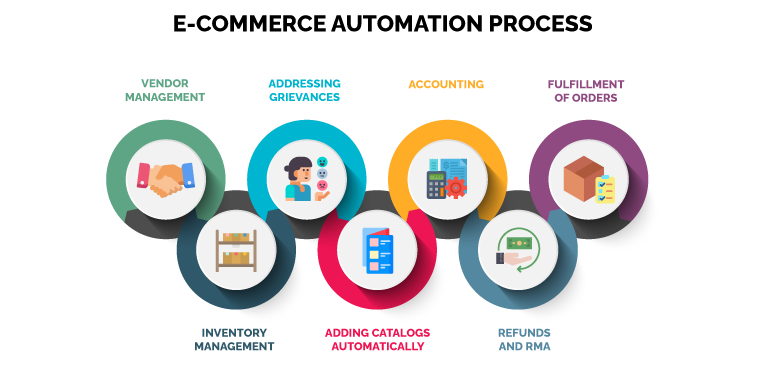
e-commerce workflow automation is a smart way to keep your business floating and flourishing day and age as businesses are developing very fast. Orders can be taken at any time when websites are operational continuously.
Of course, your staff cannot work 24/7, but that does not have to halt your business operations.
Continue reading to find out the what, why, and how of this topic and its benefits for your business.
What is e-Commerce Workflow Automation?
Time is money, you need to save it to make it.
Workflow automation is basically the streamlining of business processes i.e., the composition, delivery, and automation of human functions in a business.
The core principle is to recognize repetitive activities or any manual process that could be better done by software, applications, or technology, and instead of wasting scarce staff hours, you get the same work completed automatically.
This is extremely helpful when it comes to e-commerce, as organizations can streamline tasks that range from HR to marketing strategy. e-commerce automation platforms, no-code can help organizations achieve this.
Workflow automation is basically the streamlining of business processes i.e. the composition, delivery, and automation of human functions in a business.
e-Commerce Automation Processes
Here are a few e-commerce automation process ideas that can aid the business to be more efficient:

1. Vendor Management
All the main aspects, namely contractual specifications, contact forms, and documents to be signed, can be uploaded to process databases to be exchanged with new vendors as and when necessary. This is usually done using emails and spreadsheets.
The slowdown caused by this and possible inconsistencies in data can be streamlined and transferred from one unit to another so that the finance staff, processes, and management will accept it after making necessary changes.
2. Management of Inventory
It is essential to have an association between your e-commerce site and your system of inventory management.
Inventory management can be automated on the basis of categories, credit ratings by vendors, value, etc. Decisions and approvals are being made much faster. This increases efficiency and accuracy in purchases as well. e-commerce workflow automation thus also facilitates ease in purchase order tracking.
A two-way link is required so that every time a sale takes place in your business, a sales order will be created in your inventory management system, and there will be an update in the item’s stock.
3. Addressing Grievances/Complaints
People have a tendency to leave feedback on forums and social media. Not addressing this feedback can gradually hamper value. Bad reviews can be prevented by being a proactive seller.
e-commerce workflow automation in processing orders is vital to being highly sensitive and guaranteeing that their returns, grievances, or reviews are replied to in a timely and comprehensive manner in order to boost brand awareness.
4. Adding Lists/Catalogs Automatically
New items or services are put on websites. This comes with descriptions and images; a lot of internal approvals are required before they can go live.
Doing this would require a lot of manpower, but it can be easily automated with a workflow automation system, which will increase the site’s speed and efficiency.
5. Accounting
Every sale and purchase is taken into account. Accounting needs to occur simultaneously while changing to retail digital transformation or any buinses to digital. This would require manpower and may lead to errors, but with a workflow automation system for e-commerce in place, it can happen automatically, without mistakes.
6. Refunds and RMA
According to Wikipedia, “A return merchandise authorization (RMA), return authorization (RA) or return goods authorization (RGA) is a part of the process of returning a product to receive a refund, replacement, or repair during the product’s warranty period.“
Refunds and RMA claims differ from complaints or grievances as they have to be processed, and action must be taken at the earliest. If such requests do not get a response depicts the lethargic conduct of a company.
Addressing this manually will result in a waste of time and effort unnecessarily. Not addressing this will create an unfavorable brand image. An e-commerce workflow automation software can automate this and avoid inaccuracies or delays in the process.
7. Fulfillment of Orders
Order fulfillment is extremely important as the company’s reputation is highly dependent on this.
- If your business is low on stock, firstly, you should look at moving the order to another warehouse.
- You may ask your vendor to fill out the order if there is no stock.
- If these two solutions are not possible, you can back up the supplies and warn the customer that the delivery will take longer than normal.
So, after understanding these processes, why should you WANT to use e-commerce workflow automation?
Also read: 5 Procurement Automation Processes to Embrace Today
Why Use Workflow Automation for your e-Commerce Site?
There are many benefits of using workflow automation, especially when it comes to your backend tasks.
Benefits of e-Commerce Workflow Automation for Enterprises
- Improves efficient back-office process flows for e-commerce companies
- Makes processes less complicated
- Organizes processes well
- Increases efficiency and revenue
- Decreases workload
- Helps employees make the best use of their strengths
- Encourages faster decision-making
- Enhances information security
- Ensures continuity of the procedure
- Prevents mistakes, oversights, and miscommunication
- Creates and maintains the trust of the supplier
The last point here is of importance as the supply chain is highly benefited by workflow automation.

e-Commerce Process Flow
Mapping and understanding your e-commerce process flow is crucial in this competitive business environment. It helps identify and highlight the key areas that can be automated to ensure faster, more efficient working and maximize sales.
This flow involves –
1. Receiving
Receiving orders involves drawing out the customer order details from the business software and entering the data as an entry. When employees perform this task manually, data entry errors may occur.
Automating this process removes the employee from the picture and replaced it with a timely data entry system wherein the orders are automatically entered, and customers automatically receive a notification.
2. Processing
This includes the processing of the checked orders at the warehouse, where the availability of stock and product location is cross-referenced by employees.
By automating this process, the time spent by employees in cross-referencing will be reduced and automatically create a list.
3. Shipping
After the order has been processed in the warehouse, it then becomes fit to be forwarded to the courier for completion. The employees would need to collect shipment data, such as weight, size, location, and price, along with manually printing the shipping labels and notifying the courier to fulfill the order.
Automating the shipping process would replace manual administration since all the information would be stored in the software; the shipping labels would automatically be printed, and the customer will receive a ‘dispatched’ notification with synchronized monitoring information.
Also read: How Sales Automation Can Pave Your Way to Your Roaring Success?
No-Code can enable e-Commerce Workflow Automation
The automation of the workflow in your e-commerce business can be enabled by no-code platforms. No-code is highly convenient in today’s digital age of e-commerce businesses all over as it does not require the tech-savviness of a programmer. The need for a coder has become a thing of the past.
Workflows can be automated by a layman using a simple drag-and-drop system with an intuitive visual interface. Using no-code is helpful for businesses with lower requirements for customization.
Automation using no-code results in the following:
- providing agility to businesses
- increases the productivity of employees by saving their time and reducing their workload
- it is an effective method in terms of cost as it lowers the overhead costs over time
- it is very easily integrated
So how can you do this?
How to Streamline e-Commerce business operations with No-Code?
Your company can streamline workflow at ten times the speed and modify it with no code; there is also easier maintenance – all at the click of a button.
Here are 4 steps for e-commerce workflow automation using no-code:

1. Recognize and pinpoint tasks that are routine
Your e-commerce business will have bottlenecks in its workflow if you observe its working carefully. These productivity-hampering issues can be overcome with automation.
2. Improve the efficiency of these tasks
Decide the extent to which you want to integrate the workflow automation of your e-commerce business. The tasks that reduce productivity and waste the time of the employees should be given priority.
3. Find a solution – a platform
Look for an e-commerce workflow automation solution system. Find a platform that is successful in helping achieve the processes mentioned earlier – inventory and vendor management, order fulfillment, accounting, refunds and RMA, complaint handling, and listings approval.
4. Assess results
Assess the results and ascertain whether it is making a meaningful change. Employees must use the no-code platform correctly. The wrong usage of a no-code platform is counter-productive and can be detrimental. Understanding which processes are to be streamlined is dependent on the business objectives.
Conclusion
With e-commerce workflow automation, streamlining processes helps with both efficiency and productivity. Artificial intelligence, like bots, software, etc., is able to perform worldly tasks much faster than people. Moreover, the sort of minor mistakes that can snowball into big problems is also avoided.
When automation replaces mundane activities, employees will be able to spend their time on other activities that actually need human concentration. In this way, your business can live up to its maximum capabilities.
Quixy is a leading No-Code Process Automation Platform that can facilitate e-commerce workflow automation due to the ease and simplicity with which repetitive operations can be automated and streamlined.
We aim to create a solution for the automation of processes to aid businesses in achieving their maximum potential.
Frequently Asked Questions(FAQs)
What is workflow automation in e-commerce?
Workflow automation in e-commerce involves using technology to streamline and automate various processes within an online retail business. It includes order processing, inventory management, customer communications, and other operational tasks.
What is e-commerce automation?
E-commerce automation refers to the use of technology to automate repetitive tasks and processes in online retail, such as order processing, inventory management, and customer support, improving efficiency and reducing manual efforts.
What is the workflow of an e-commerce store?
The workflow of an e-commerce store typically includes stages like product listing, order placement, payment processing, order fulfillment, shipping, and customer feedback. Each stage involves specific tasks that contribute to a seamless customer experience.
What is an e-commerce workflow diagram?
An e-commerce workflow diagram visually represents the sequence of steps and tasks involved in the operation of an online store. It illustrates how different processes are connected and how data flows within the system.
Why use workflow automation for e-commerce sites?
Workflow automation in e-commerce enhances efficiency by automating routine tasks, reducing errors, and ensuring consistency. It accelerates processes like order fulfillment, inventory management, and customer communication, leading to a more streamlined and responsive online retail operation.
Login
Please login to comment
0 Comments
Oldest















